Geopolymer Concrete Market
The Geopolymer Concrete market is transitioning from pilot projects to early mainstream adoption as asset owners seek lower-carbon, high-durability alternatives to Portland cement binders. Geopolymer systems - typically based on aluminosilicate precursors such as fly ash, slag, calcined clays/metakaolin, red mud, or natural pozzolans activated with alkaline solutions - offer fast strength gain, superior chemical/acid resistance, low shrinkage, and reduced embodied CO₂. Top applications span transportation infrastructure (pavements, precast bridge elements, sleepers), marine and industrial assets (sulfate/chloride environments), buildings (precast panels, blocks), mining backfill, and repair/shotcrete. Current trends include one-part “just-add-water” dry activators replacing caustic liquid mixes, ambient-cure formulations that remove heat-curing constraints, and hybrid binders that blend small percentages of Portland cement for set control and finishing. Demand is underpinned by decarbonization mandates, durability-driven lifecycle savings, and the availability of industrial by-products; parallel drivers include corporate Scope-3 targets and public procurement criteria rewarding low-carbon materials. The competitive landscape spans specialty binder formulators, admixture suppliers, precast producers, and ready-mix providers building geopolymer lines; differentiation centers on precursor flexibility, workability windows, ambient cure capability, finish quality, and proven long-term performance data. Key challenges include variability of industrial feedstocks, standards and design-code maturity, contractor familiarity, curing management in cold climates, and supply reliability of activators. Overall, suppliers that combine consistent binders, robust QA on variable precursors, practical placement guidance, and third-party durability evidence are best positioned as owners increasingly evaluate whole-life cost and carbon alongside schedule and constructability.Geopolymer Concrete Market Key Insights
- Decarbonization as the anchor value: Geopolymers deliver substantial embodied-carbon reductions versus OPC, helping owners meet net-zero roadmaps without sacrificing strength or durability - especially compelling in public works tendering.
- Durability in aggressive exposure: Superior resistance to chlorides, sulfates, acids, and high-temperature cycles makes geopolymers attractive for marine, wastewater, and industrial assets where lifecycle OPEX dominates.
- Ambient-cure progress unlocks ready-mix: New chemistries enable ambient or mild-temperature curing, expanding use beyond precast to slabs, pavements, and structural elements without specialty curing regimes.
- One-part activators simplify site use: Dry, blended activators reduce handling risks of high-alkali liquids, improve batching accuracy, and enhance contractor acceptance and safety compliance.
- Precursor diversification hedges supply: Beyond fly ash and GGBS, metakaolin and calcined clay routes de-risk declining ash availability and enable regional supply chains with stable quality.
- Workability and finish quality improve: Tailored admixtures, rheology modifiers, and hybrid binders deliver pumpable mixes, extended open time, and finish characteristics closer to OPC concretes.
- Design standards catch up: Emerging specifications, acceptance criteria, and performance-based testing frameworks are accelerating approvals; early collaboration with engineers reduces perceived risk.
- Precast leads, in-situ follows: Precast plants control curing and QA, proving performance in sleepers, culverts, and façades; lessons learned then migrate to cast-in-place pavements and repairs.
- Total-cost-of-ownership wins bids: Longer service life, reduced maintenance, and chemical resistance can offset premium binder costs - especially where shutdowns or corrosion drive lifecycle economics.
- Training & QA are decisive: Mix design playbooks, activator handling SOPs, and on-site QC (temperature, moisture, set monitoring) underpin repeatability and stakeholder confidence.
Geopolymer Concrete Market Reginal Analysis
North America
Adoption is propelled by state/municipal low-carbon procurement, resilience needs in coastal/wastewater assets, and precast manufacturers adding geopolymer lines. Declining Class F fly-ash availability pushes metakaolin and slag-rich blends. Pilot approvals in transportation and DOT specs expand reference projects. Contractor education, winter curing strategies, and standardized submittals are key to scaling ready-mix deployments.Europe
Strong policy pressure on embodied carbon, mature precast ecosystems, and circular-economy agendas favor geopolymers for infrastructure, rail, and marine works. Calcined clay/metakaolin supply supports consistent quality as coal by-products wane. Performance-based standards and EPDs shape procurement. Northern regions emphasize cold-weather curing guidance; Western Europe prioritizes architectural finishes and hybrid binders for on-site works.Asia-Pacific
Scale and industrial by-product streams (slag, fly ash, red mud) support cost-competitive binders. Australia and New Zealand lead in specifications and marine/transport case studies; Japan and Korea focus on durability R&D; India and Southeast Asia leverage ambient-cure mixes for roads and precast components. Rapid urbanization and coastal exposure create strong use cases, with public pilots accelerating acceptance.Middle East & Africa
Harsh chloride/sulfate environments and high temperatures align well with geopolymer durability and early strength. Availability of slag and natural pozzolans enables local formulations. Government mega-projects and industrial facilities are early adopters, with emphasis on pumpability, hot-weather set control, and long-term corrosion performance. Training and robust QA/QC systems are critical given wide contractor ecosystems.South & Central America
Mining, marine, and industrial assets create demand for acid/chloride-resistant concretes. Regional availability of slag and pozzolans supports geopolymer supply, while public works programs explore low-carbon materials for bridges and pavements. Adoption grows first in precast and repair mortars, then extends to pavements as ambient-cure recipes mature. Supplier partnerships with universities and agencies help codify specs.Geopolymer Concrete Market Segmentation
By Material
- Fly Ash-Based Geopolymer Concrete
- Slag-Based Geopolymer Concrete
- Others
By End-User
- Residential
- Commercial
- Industrial
- Infrastructure & Public Works
Key Market players
Wagners, Banah UK, Zeobond Pty Ltd, Murray & Roberts, Ecocem, BASF SE, CEMEX, Geopolymer Solutions, Milliken Infrastructure, The Siam Cement Group, Schlumberger Limited, Kiran Global Chem, Alchemy Geopolymer, C-Tech Innovations, Solidia TechnologiesGeopolymer Concrete Market Analytics
The report employs rigorous tools, including Porter’s Five Forces, value chain mapping, and scenario-based modelling, to assess supply-demand dynamics. Cross-sector influences from parent, derived, and substitute markets are evaluated to identify risks and opportunities. Trade and pricing analytics provide an up-to-date view of international flows, including leading exporters, importers, and regional price trends.Macroeconomic indicators, policy frameworks such as carbon pricing and energy security strategies, and evolving consumer behaviour are considered in forecasting scenarios. Recent deal flows, partnerships, and technology innovations are incorporated to assess their impact on future market performance.
Geopolymer Concrete Market Competitive Intelligence
The competitive landscape is mapped through proprietary frameworks, profiling leading companies with details on business models, product portfolios, financial performance, and strategic initiatives. Key developments such as mergers & acquisitions, technology collaborations, investment inflows, and regional expansions are analyzed for their competitive impact. The report also identifies emerging players and innovative startups contributing to market disruption.Regional insights highlight the most promising investment destinations, regulatory landscapes, and evolving partnerships across energy and industrial corridors.
Countries Covered
- North America - Geopolymer Concrete market data and outlook to 2034
- United States
- Canada
- Mexico
- Europe - Geopolymer Concrete market data and outlook to 2034
- Germany
- United Kingdom
- France
- Italy
- Spain
- BeNeLux
- Russia
- Sweden
- Asia-Pacific - Geopolymer Concrete market data and outlook to 2034
- China
- Japan
- India
- South Korea
- Australia
- Indonesia
- Malaysia
- Vietnam
- Middle East and Africa - Geopolymer Concrete market data and outlook to 2034
- Saudi Arabia
- South Africa
- Iran
- UAE
- Egypt
- South and Central America - Geopolymer Concrete market data and outlook to 2034
- Brazil
- Argentina
- Chile
- Peru
Research Methodology
This study combines primary inputs from industry experts across the Geopolymer Concrete value chain with secondary data from associations, government publications, trade databases, and company disclosures. Proprietary modeling techniques, including data triangulation, statistical correlation, and scenario planning, are applied to deliver reliable market sizing and forecasting.Key Questions Addressed
- What is the current and forecast market size of the Geopolymer Concrete industry at global, regional, and country levels?
- Which types, applications, and technologies present the highest growth potential?
- How are supply chains adapting to geopolitical and economic shocks?
- What role do policy frameworks, trade flows, and sustainability targets play in shaping demand?
- Who are the leading players, and how are their strategies evolving in the face of global uncertainty?
- Which regional “hotspots” and customer segments will outpace the market, and what go-to-market and partnership models best support entry and expansion?
- Where are the most investable opportunities - across technology roadmaps, sustainability-linked innovation, and M&A - and what is the best segment to invest over the next 3-5 years?
Your Key Takeaways from the Geopolymer Concrete Market Report
- Global Geopolymer Concrete market size and growth projections (CAGR), 2024-2034
- Impact of Russia-Ukraine, Israel-Palestine, and Hamas conflicts on Geopolymer Concrete trade, costs, and supply chains
- Geopolymer Concrete market size, share, and outlook across 5 regions and 27 countries, 2023-2034
- Geopolymer Concrete market size, CAGR, and market share of key products, applications, and end-user verticals, 2023-2034
- Short- and long-term Geopolymer Concrete market trends, drivers, restraints, and opportunities
- Porter’s Five Forces analysis, technological developments, and Geopolymer Concrete supply chain analysis
- Geopolymer Concrete trade analysis, Geopolymer Concrete market price analysis, and Geopolymer Concrete supply/demand dynamics
- Profiles of 5 leading companies - overview, key strategies, financials, and products
- Latest Geopolymer Concrete market news and developments
Additional Support
With the purchase of this report, you will receive:- An updated PDF report and an MS Excel data workbook containing all market tables and figures for easy analysis.
- 7-day post-sale analyst support for clarifications and in-scope supplementary data, ensuring the deliverable aligns precisely with your requirements.
- Complimentary report update to incorporate the latest available data and the impact of recent market developments.
This product will be delivered within 1-3 business days.
Table of Contents
Companies Mentioned
- Wagners
- Banah UK
- Zeobond Pty Ltd.
- Murray & Roberts
- Ecocem
- BASF SE
- CEMEX
- Geopolymer Solutions
- Milliken Infrastructure
- The Siam Cement Group
- Schlumberger Limited
- Kiran Global Chem
- Alchemy Geopolymer
- C-Tech Innovations
- Solidia Technologies
Table Information
| Report Attribute | Details |
|---|---|
| No. of Pages | 160 |
| Published | November 2025 |
| Forecast Period | 2025 - 2034 |
| Estimated Market Value ( USD | $ 8.19 Billion |
| Forecasted Market Value ( USD | $ 19.47 Billion |
| Compound Annual Growth Rate | 10.1% |
| Regions Covered | Global |
| No. of Companies Mentioned | 15 |









